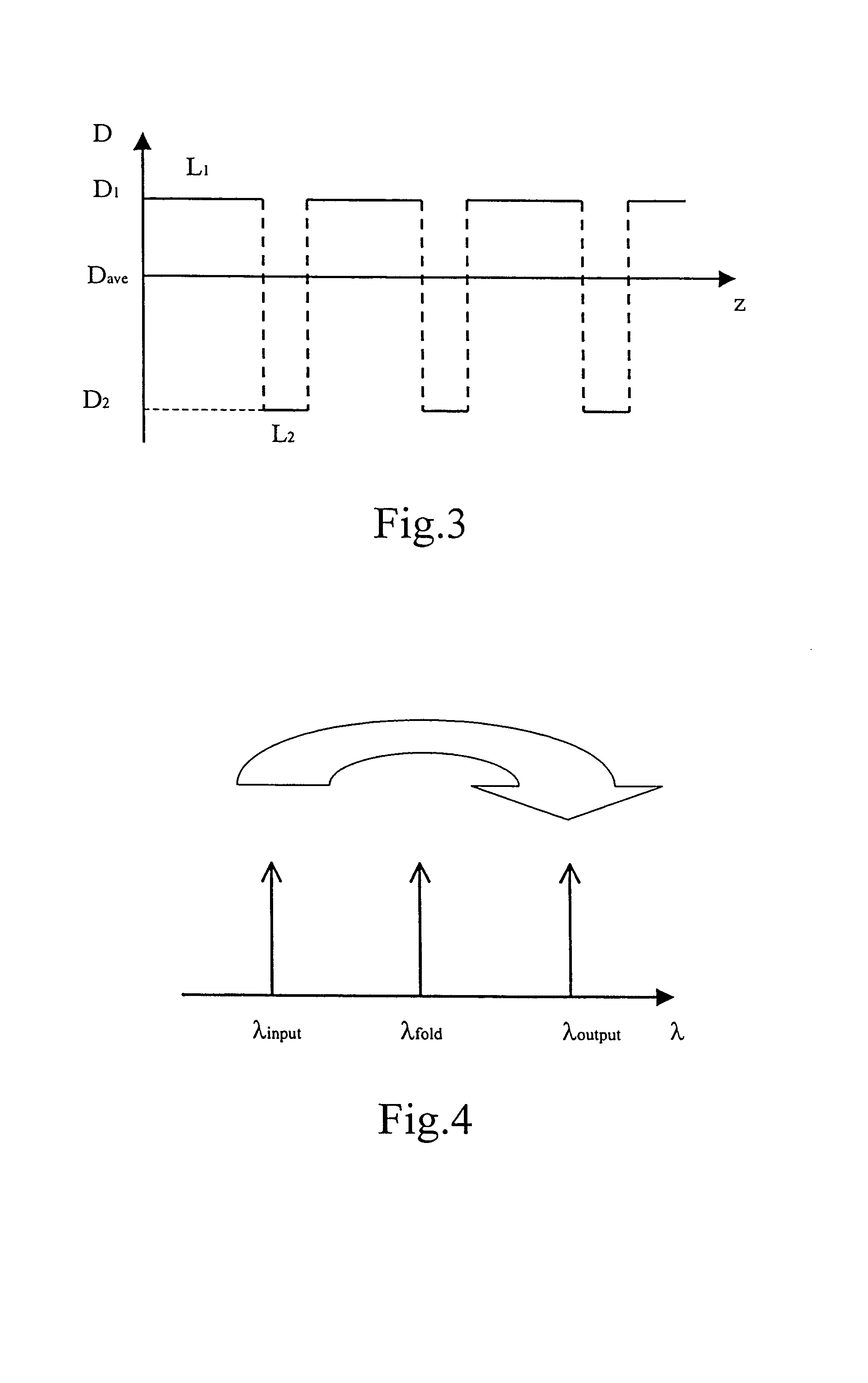Wavelength division multiplexing optical transmission system using a spectral inversion device
a wavelength division multiplexing and optical transmission technology, applied in wavelength-division multiplex systems, optical transmission, multi-component communication, etc., can solve the problems of insufficient use of dcf fibres, inability to compensate the dispersion over inability to achieve optimal solutions for the whole signal band, etc., to achieve low reception errors and easy implementation in the system
- Summary
- Abstract
- Description
- Claims
- Application Information
AI Technical Summary
Benefits of technology
Problems solved by technology
Method used
Image
Examples
example 1
[0133]The launch of under-compensated channels in a wavelength range from 1550 nm to 1561.2 nm, in a system with the characteristics described above, was simulated. The power per channel was 8 dBm. The pulses had a time interval of 25 ps and a width of 3 ps. Before input into the spans of optical fibres with alternating dispersion, a pre-compensation of +50 ps2 was added to all the channels. The simulation was conducted without the spectrum and wavelength conversion device. The performance of the system was evaluated by determining the quantity of post-compensation to be applied, for all the channels, at the ends of the five spans of fibre. In particular, what is known as the “eye-opening”, in other words the difference between the least powerful “1” bit and the most powerful “0” bit, was measured, for each transmitted channel and with different values of post-compensation, at the transmission station and at the receiving station. The difference between the transmitted eye-opening a...
example 2
[0134]The simulation described with reference to Example 1 was repeated, with a spectrum and wavelength conversion device inserted after the fourth span of pairs of optical fibres. The folding radiation of the device had a wavelength of 1561.6 nm. Downstream of the conversion device, the channels had wavelengths in the range from 1562 nm to 1573.2 nm. FIG. 11 shows the result of the simulation. The wavelengths shown on the horizontal axis correspond to the wavelengths of the transmitted channels (upstream of the conversion). The level curves show, with the respective kind of line, the same maximum penalties as those shown in Example 1. It may be noted that the useful bandwidth for obtaining a penalty level less than or equal to 0.5 dB shown in FIG. 11 extends through the whole region from 1550 to 1561.2. As can be seen more clearly from FIG. 11, it can also extend into values above 1561.2. This corresponds to a wavelength band of more than 11 nm. This means that it is possible to co...
example 3
[0135]The simulations described with reference to Examples 1 and 2 were repeated, with the average power per channel raised to 10 dBm. In the case without a conversion device, the 0.5 dB maximum penalty band was found to be further confined to a wavelength region between 1550 and 1552 nm. In other words, for a typical channel spacing of 200 GHz (1.6 nm) (at 40 Gbit / s), a maximum of two channels with wavelengths above 1550 nm can be compensated while maintaining a penalty level less than or equal to 0.5 dB. With the conversion device, a 0.5 dB maximum penalty band of approximately 11 nm could still be obtained. In other words, for a typical channel spacing of 200 GHz (1.6 nm) (at 40 Gbit / s), seven to eight channels having wavelengths above 1550 nm can be compensated while maintaining a penalty level less than or equal to 0.5 dB.
PUM
 Login to View More
Login to View More Abstract
Description
Claims
Application Information
 Login to View More
Login to View More - R&D
- Intellectual Property
- Life Sciences
- Materials
- Tech Scout
- Unparalleled Data Quality
- Higher Quality Content
- 60% Fewer Hallucinations
Browse by: Latest US Patents, China's latest patents, Technical Efficacy Thesaurus, Application Domain, Technology Topic, Popular Technical Reports.
© 2025 PatSnap. All rights reserved.Legal|Privacy policy|Modern Slavery Act Transparency Statement|Sitemap|About US| Contact US: help@patsnap.com



